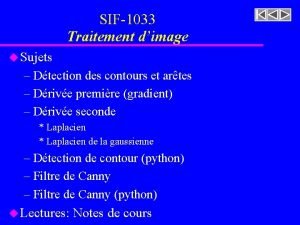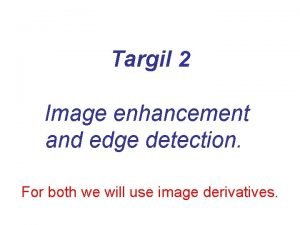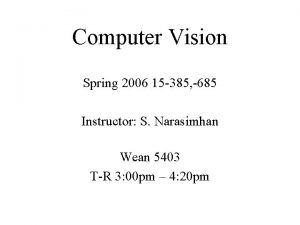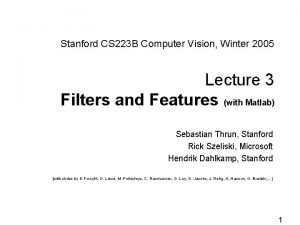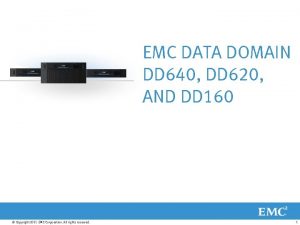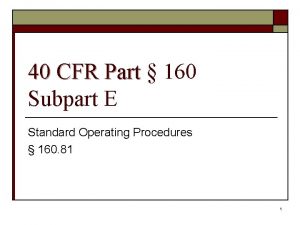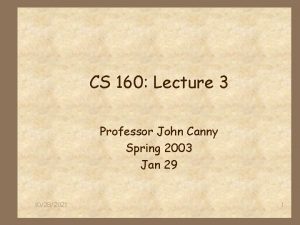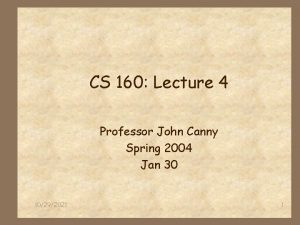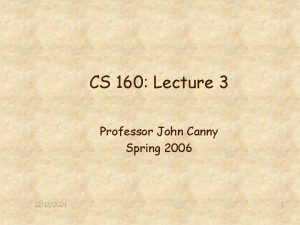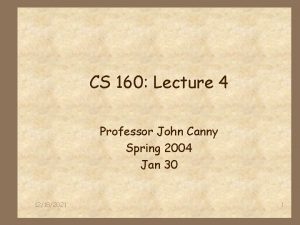CS 160 Lecture 21 Professor John Canny Spring


































- Slides: 34

CS 160: Lecture 21 Professor John Canny Spring 2003 9/17/2021 1

Quiz on Information Design 9/17/2021 2

Handouts 1. Reading for this time: Handling Errors (Lewis and Norman). 2. Reading for next time: Help and docs (Chapter from Dix et al. ) 3. Next assignment (Final project report/presentation). 4. Consent forms. 5. Quiz for last class. 9/17/2021 3

Design for Errors 4 Some favorite error messages: * 404 not found * Fatal error 312: aborting * Syntax error near line 1025 * Internal compiler error * Segmentation fault: core dumped 4 What do these messages communicate? 4 What is the solution to each? 9/17/2021 4

Naïve users 4 Fatal error 312: * User messed up and someone will die (computer? ). * Solution: log off and pretend nothing happened. 4 404 not found * The computer misplaced something (the “ 404”? ). * Solution: Maybe it will find it if you try later… 4 Segmentation Fault: core dumped * Something bad happened * Solution: someone will probably have to clean out the “core” stuff that was dumped inside the computer. 9/17/2021 5

More sophisticated users 4 Segmentation fault: core dumped * This lazy programmer slept through their programming classes and didn’t learn about array bounds checking, invariants or memory management. * Solution: Move them to the user support hotline 9/17/2021 6

More sophisticated users 4 404 + the other messages * Why can’t programmers explain what is wrong in normal English? * Why do the messages sound like bad movie titles? “fatal error” etc. * Why do programmers usually assume that the user did something wrong when their program crashes? 9/17/2021 7

User studies 4 Solution for programmers: * Test out error messages in person on your boss. * E. g. walk into office, say “segmentation fault: core dumped”, deposit printout of memory on their desk, and walk out. 4 Why isn’t this is good idea? 4 Why is it a good idea to put it into a program? 9/17/2021 8

Human error recovery 4 People make mistakes in communication all the time, and are adept at repairing them. 4 Repair need not involve assignment of blame. 4 E. g. “I’m sorry, I didn’t understand. Can you rephrase? ” * Tells the speaker you heard what they said, but were unable to interpret it. They should repeat, but express it differently. * There is no assertion that what they said was ungrammatical or incorrect, and you accept some blame by default. 9/17/2021 9

Human error recovery 4 Aside: Users respond better when machine dialogue matches their own personality. 4 Reeves and Nass studied this phenomenon in text-based OS’es, and used Myers-Briggs personality types. 9/17/2021 10

Humane error recovery 4 In human communication, an error is the beginning of a process of repair. It is “normal” to make errors. 4 In human-machine interaction, errors normally lead to the end of the current task. Errors are treated as “abnormal”. 4 In other words, user interfaces usually try to escape from the repair process, leaving the user stranded. 9/17/2021 11

Types of errors 4 Mistakes * User intended to do what they did, and it led to an error. User would probably do the same thing again. 4 Slips * User did not mean to do what they did. They can recover by doing it differently again. * Slips are not just for beginners. Experts often make them because they devote less conscious attention to the task. 9/17/2021 12

Minimizing Error 4 System errors: Program defensively (assert, bounds check (please!!)) 4 Estimated loss of productivity due to Windows OS crashes $170 B. 4 Estimate for Windows XP $17 B. 4 Note: almost all Windows XP vulnerabilities are standard buffer overruns. 9/17/2021 13

Minimizing Error 4 User errors: * Use Intuitive command names. * Include short explanations as “tool tips”. * Put longer explanations in help system. 9/17/2021 14

Minimizing Error 4 Recognition over recall * Easier to select a file icon from a folder than to remember and type in the filename. * Auto-completion can help fix this. 4 Use appropriate representations * E. g. graphical file selector good for choosing individual files * Textual file names support automation, richer organization (using command line options). 9/17/2021 15

Typical Errors 4 From Norman’s 1983 survey: 4 Mode errors: * User forgets what mode they’re in, and does the command appropriate for another mode. * Digital watches, VCRs etc. * Common where there aren’t enough command keys for all the operations * You can still explain the mode by giving the user feedback on what keys do in the display. 9/17/2021 16

Typical Errors 4 Description error: * The action is insufficiently specified by the user. * User may not know all the command line switches, or all the installation options for a program. * Solution: Warn the user that the command is ambiguous, or “unusual”. Provide help about options in several standard ways. 9/17/2021 17

Typical Errors 4 Capture error: * Command sequences overlap, and one is more common. * User reflexively does the common one when trying to do the unusual one. * E. g. try typing “soliton” very fast. 9/17/2021 18

Detecting Errors 4 The earlier the better: * Check for consistency whenever possible (“asserts” for user input). * If there’s a high risk of error, check for unusual input, or for common slips (spelling correction). 4 E. g. google’s “did you mean XX? ” response 9/17/2021 19

System Response 4 Stop the user from continuing the way they were going (possibly compounding the error). 4 Take “safe” recovery actions - e. g. auto-save the state with a unique name. 4 Begin the recovery process. 9/17/2021 20

System Responses 4 Gag 4 Warn 4 Do Nothing 4 Self Correct 4 Teach Me 4 Let’s talk about it 9/17/2021 21

Gag Response 4 Machine freezes, often not even accepting input. 4 Generally a bad idea, but there are good uses: * Raskin’s FLOW system, refuses to accept keystrokes that are not legal commands. * Intended for naïve users. * Even random typing produces legal programs! 9/17/2021 22

Warn Response 4 Machine accepts input, even if not legal. Warns user about problem(s). 4 Allows user to get into deeper trouble. 4 Allow backtracking “undo”, back to start of trouble if possible. 9/17/2021 23

Do Nothing Response 4 Machine accepts input, even if not legal. Machine does nothing 4 User has to figure out that something’s wrong. 4 Usually a bad idea, but sometimes useful in automation (don’t copy file to itself etc. ). 9/17/2021 24

Self Correct 4 DWIM (Do What I Mean) was an aggressive self-correcting system. Spell checkers are of this type. 4 Generally good but: * Sometimes override user intent. * Can frustrate on frequently-used strings: “naïve” is good but not “Hsi”. * Solutions: + Don’t repeat correction if overridden. + Watch user behavior over time. 9/17/2021 25

Let’s talk about it 4 Inspired by human error recovery. * Machine explains its understanding of the situation, gives the user some options. * Examples: network diagnostic wizard, modem wizard, … 4 Very difficult to program these, but they’re very valuable. * Need some analysis of previous user problems. * Look at help desk logs. 9/17/2021 26

Teach Me 4 System informs user what they can do. 4 Common in speech recognizers. Include command “what can I say? ”, or run speech tutorial. 9/17/2021 27

Explanations 4 The first part of the recovery process is to explain what appears to be wrong. 4 Remember the user is only supposed to have a functional model of what’s going on. Try to give an explanation at high level. 4 People understand basic resources like filespace, memory etc. 4 “I’m afraid the program has an internal fault in the code that <<reads and writes files>>, which was called when trying to <<save your user preferences>>. We regret the inconvenience, and are trying to recover…” 9/17/2021 28

Recovery 4 The system should always give the user a reasonable amount of information about the problem. 4 Better to err on the side of too much information. 4 Some problems are amenable to automatic repair: retry, use redundant information, backup data etc… 4 DWIM (Do What I mean) was an editor that attempted to correct common user errors. You need an “undo” key to use this approach. 9/17/2021 29

Recovery 4 Run a “diagnostic wizard” for common or unreliable subsystems (e. g. the network). 4 These can interact with the user to get extra information needed to fix the problem. 9/17/2021 30

Research Approaches 4 Intentional interfaces: build models of user intention from their actions. 4 Assumes that people have clear goals that the system can understand. 4 Can get confused if people multi-task or do sub-optimal things. 9/17/2021 31

Research Approaches 4 Accountable systems: The system maintains a user-oriented model of internal behavior, somewhere between a structural and a functional model. 4 If an error occurs, this “account” can give a sensible explanation, and often recovery suggestions. 9/17/2021 32

Summary 4 Error messages are often masterpieces in bad communication. That’s not necessary. 4 Error recovery is a “normal” process. 4 Types of errors: slips and mistakes. 4 Some common error types. 4 Five responses to errors. 4 Recovery. 4 Research approaches. 9/17/2021 33

Wrap-up 4 SAVE your notes! 4 Fill out survey on Livenotes if you’re using it. 4 Hand in Pilot Usability Assignment. 9/17/2021 34
 Qual tipo de filtro é o de canny?
Qual tipo de filtro é o de canny? What is canny edge detection in image processing
What is canny edge detection in image processing Filtre de canny python
Filtre de canny python Targil seasoning
Targil seasoning Joe canny
Joe canny Canny
Canny Canny
Canny Canny sebastian
Canny sebastian Canny mask
Canny mask Promotion from assistant to associate professor
Promotion from assistant to associate professor A college professor never finishes his lecture
A college professor never finishes his lecture Professor green lecture 1
Professor green lecture 1 01:640:244 lecture notes - lecture 15: plat, idah, farad
01:640:244 lecture notes - lecture 15: plat, idah, farad Spring, summer, fall, winter... and spring cast
Spring, summer, fall, winter... and spring cast February is winter or spring
February is winter or spring Professor john forsythe
Professor john forsythe Professor john forsythe
Professor john forsythe Professor john wood
Professor john wood Holland self directed search
Holland self directed search Feedback hattie effect size
Feedback hattie effect size Professor john hughes
Professor john hughes Professor john stanley
Professor john stanley 45 sayısı 180 sayısının yüzde kaçıdır
45 sayısı 180 sayısının yüzde kaçıdır Smt 160
Smt 160 12vac35-105-520
12vac35-105-520 Wac 296-800-160
Wac 296-800-160 Patrick liang
Patrick liang Konica minolta bizhub 160
Konica minolta bizhub 160 Parafrasi il canto delle sirene dal verso 160
Parafrasi il canto delle sirene dal verso 160 Data domain dd160 price
Data domain dd160 price 40 cfr part 160
40 cfr part 160 Carolina windom 80
Carolina windom 80 160 fifth avenue nyc
160 fifth avenue nyc A 6ft tall tent standing next
A 6ft tall tent standing next Un tercio cuanto es
Un tercio cuanto es


